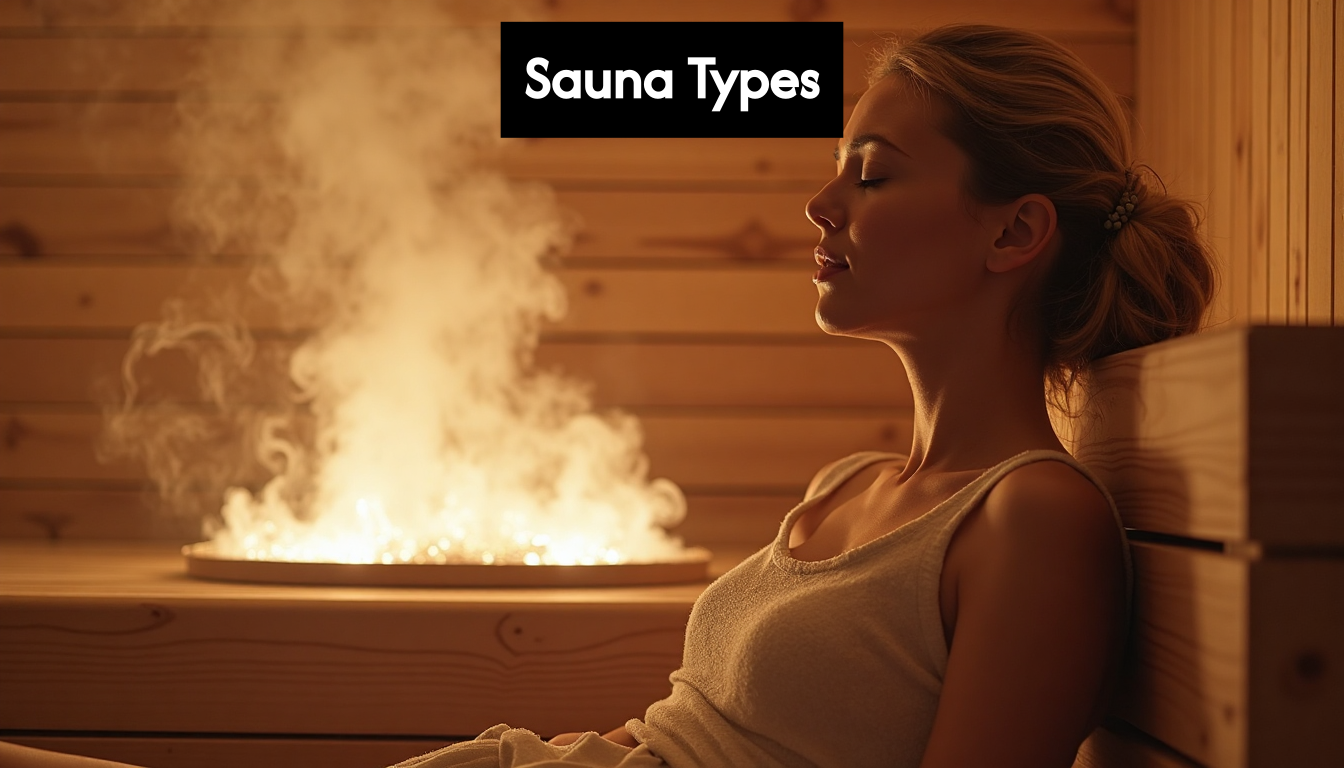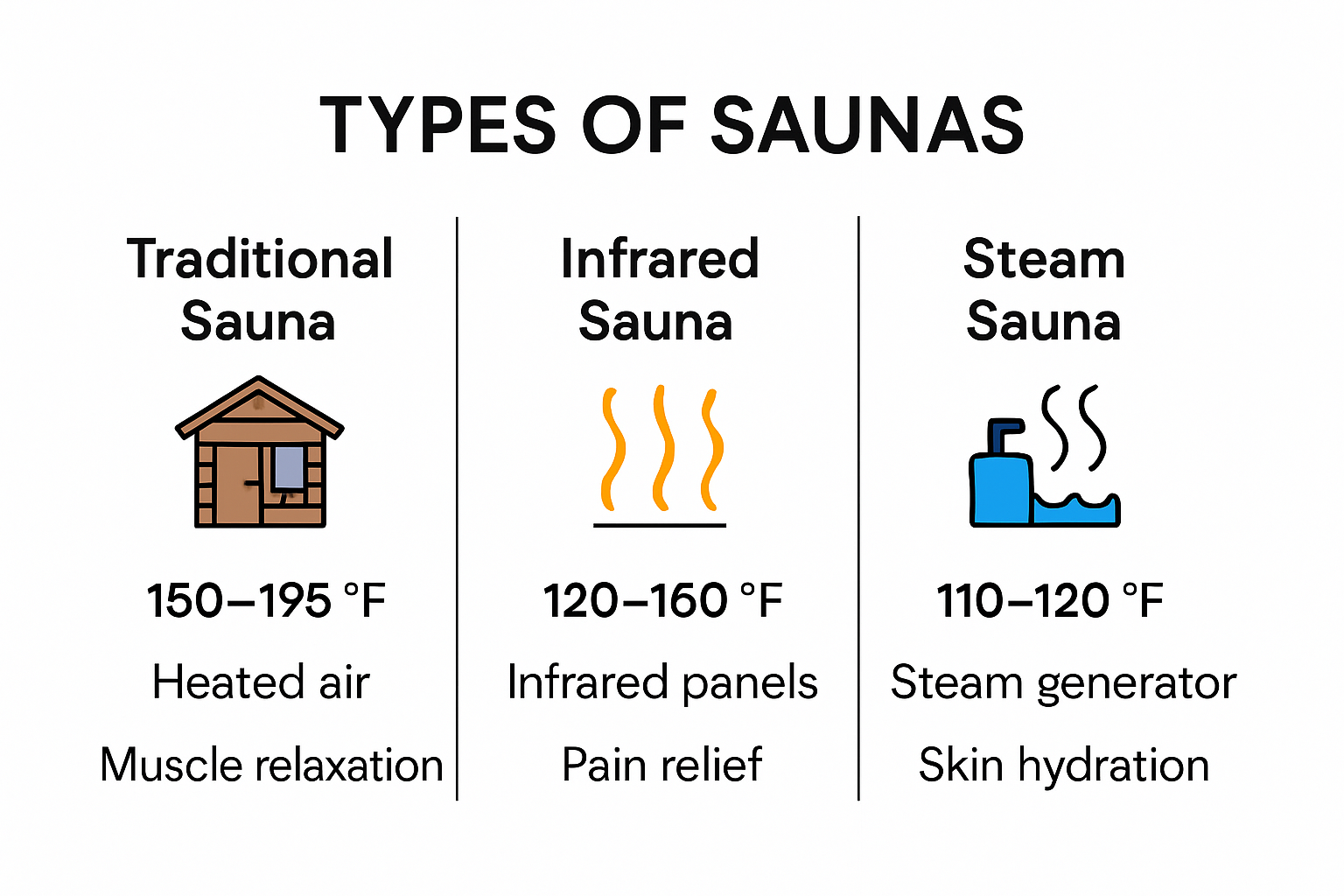
Understanding Sauna Types: immersive guide 2025

Choosing the right sauna can feel overwhelming, especially with so many options available today. It’s fascinating to note that the US sauna market is projected to reach $151.3 million by 2029, reflecting a growing interest in personalized wellness. But here’s the kicker: many people assume all saunas offer the same benefits. The truth is, each sauna type provides unique features and health advantages that cater to different wellness goals. Understanding these differences could change your health journey forever.
Table of Contents
Quick Summary
| Takeaway | Explanation |
|---|---|
| Understand sauna types | Different sauna types, such as traditional, infrared, and specialized saunas, offer unique health benefits and experiences tailored to personal wellness goals. |
| Consider health benefits | Regular sauna use can enhance cardiovascular performance, accelerate muscle recovery, and reduce stress, making it essential to choose based on individual health objectives. |
| Assess physical comfort | Factors like heat tolerance, humidity sensitivity, and existing health conditions are crucial in selecting the sauna type that ensures a comfortable experience. |
| Consult professionals | Seeking advice from healthcare providers can help identify any contraindications and guide the integration of sauna therapy into personal wellness routines. |
| Evaluate practical needs | Consider budget, space, and long-term maintenance when choosing a sauna, as these factors significantly influence the overall sauna experience. |
Explore Different Sauna Types
Understanding sauna types is crucial for selecting the right wellness experience that matches your health goals and personal preferences. The sauna market offers diverse options, each with unique characteristics designed to provide relaxation, recovery, and therapeutic benefits.
Traditional Saunas: The Classic Heat Experience
Traditional saunas represent the time-honored approach to heat therapy, originating from Finnish cultural practices. These saunas typically operate at high temperatures ranging from 150-195°F, creating an intense heat environment that induces profound sweating and promotes deep relaxation. Research from the North American Sauna Society indicates that traditional saunas use either wood-burning or electric heaters to generate heat, often featuring rocks that can be sprinkled with water to create steam and increase humidity.
Key characteristics of traditional saunas include:
- Intense heat delivering rapid perspiration
- Longer heat-up times (30-40 minutes)
- Social and communal atmosphere
- Option for wet (steam) or dry heat experiences
Infrared Saunas: Modern Therapeutic Heating
Infrared saunas represent a technological evolution in heat therapy, operating at lower temperatures (120-150°F) while delivering direct radiant heat to the body. Unlike traditional saunas, infrared models heat the body directly rather than warming the surrounding air. Market research from Grand View Research suggests that infrared saunas are gaining significant popularity due to their energy efficiency and targeted therapeutic benefits.
Unique advantages of infrared saunas include:
- Faster heat-up times (10-20 minutes)
- Lower operating temperatures
- More focused muscle and tissue penetration
- Enhanced potential for detoxification and recovery
Specialized Sauna Types: Expanding Wellness Options
Beyond traditional and infrared categories, specialized sauna types continue to emerge, catering to specific wellness needs. Steam saunas, for instance, provide high-humidity environments beneficial for respiratory health, while portable infrared sauna blankets offer convenient at-home solutions for individuals with limited space.
The US sauna market analysis projects significant growth, expecting the market to reach $151.3 million by 2029, with a compound annual growth rate of 6.4%. This expansion reflects increasing consumer interest in personalized wellness technologies and home-based health solutions.
When exploring sauna types, consider factors like available space, budget, health objectives, and personal comfort preferences. Each sauna type offers distinct benefits, and understanding these differences empowers you to make an informed decision that aligns with your wellness journey.
Compare Sauna Benefits and Features

Comparing sauna benefits and features reveals a complex landscape of wellness technologies designed to enhance physical and mental health. Understanding the nuanced differences between sauna types can help individuals make informed decisions about their personal wellness strategies.
Health and Physiological Benefits
Research from the International Journal of Circumpolar Health demonstrates that regular sauna use offers profound health advantages. Users experience significant improvements in cardiovascular function, with studies indicating up to a 50% reduction in cardiovascular disease risk. The thermal stress induced by sauna sessions triggers multiple physiological responses that contribute to overall wellness.
Key physiological benefits include:
- Enhanced cardiovascular performance
- Improved circulation and blood flow
- Accelerated muscle recovery
- Potential reduction in chronic pain symptoms
- Natural stress reduction mechanism
Temperature and Therapeutic Mechanisms
Different sauna types deliver unique therapeutic mechanisms through varied temperature approaches. Traditional saunas operate at higher temperatures (150-195°F), creating intense heat environments that prompt rapid sweating and cardiovascular stimulation. In contrast, infrared saunas function at lower temperatures (120-150°F), providing direct radiant heat that penetrates deeper into body tissues.

Scientific research from the Mayo Clinic suggests that these different heating mechanisms offer distinct advantages:
- Traditional saunas: Promote intense detoxification through profuse sweating
- Infrared saunas: Enable longer, more comfortable sessions with targeted muscle and tissue penetration
- Steam saunas: Support respiratory health through high-humidity environments
Performance and Recovery Applications
Athletes and fitness enthusiasts increasingly incorporate sauna sessions into their recovery and performance optimization strategies. Studies published in sports medicine journals highlight the potential for improved muscle recovery, reduced inflammation, and enhanced overall physical resilience.
The thermal stress experienced during sauna sessions triggers heat shock proteins, which play a crucial role in cellular repair and adaptation. This biological response contributes to improved muscle regeneration, reduced exercise-induced muscle damage, and potentially enhanced endurance performance.
When selecting a sauna, consider individual health goals, tolerance for heat, available space, and budget. Each sauna type offers unique benefits, and the optimal choice depends on personal wellness objectives and physiological responses to thermal stress. Consulting healthcare professionals can provide personalized guidance on integrating sauna therapy into your wellness routine.
Which Sauna Type for You?
Selecting the right sauna type requires careful consideration of personal health goals, physical conditions, and lifestyle preferences. Understanding the nuanced differences between sauna options can help you make an informed decision that maximizes wellness benefits and ensures a comfortable experience.
Matching Sauna Types to Personal Health Goals
Research from the Bangor University wellness project emphasizes the importance of matching sauna protocols to individual physiological needs. Different sauna types offer unique advantages that cater to specific wellness objectives.
Consider your primary wellness goals:
- Cardiovascular health: Traditional high-heat saunas may provide more intense cardiovascular stimulation
- Muscle recovery: Infrared saunas offer targeted, gentler heat penetration
- Respiratory support: Steam saunas provide moisture beneficial for breathing
- Stress reduction: Choose a sauna type that feels most relaxing to you
Physical Considerations And Comfort Factors
Experts from Epic Hot Tubs highlight the critical differences between dry and wet sauna experiences. Your physical tolerance, medical history, and comfort preferences play a significant role in selecting the most suitable sauna type.
Key physical factors to evaluate:
- Heat tolerance (high vs. low temperature preferences)
- Humidity sensitivity
- Existing health conditions
- Fitness level and recovery needs
- Available home space
Practical Selection Strategy
According to the Home Depth Sauna Guide, selecting the ideal sauna involves a comprehensive assessment of personal needs and practical constraints. Traditional Finnish saunas offer intense heat (150–195°F) with high sweating potential, while infrared models provide gentler warmth (120–150°F) with deeper tissue penetration.
Practical selection steps:
- Consult your healthcare provider about potential contraindications
- Test different sauna types if possible
- Consider budget and installation requirements
- Evaluate long-term maintenance needs
- Assess personal comfort with various heat and humidity levels
Remember that the perfect sauna is not a one-size-fits-all solution. Your ideal choice should align with your wellness goals, physical comfort, and lifestyle preferences. Take time to research, ask questions, and potentially try different sauna experiences before making a final decision. Each individual’s wellness journey is unique, and the right sauna can be a powerful tool in supporting your overall health and relaxation objectives.
Frequently Asked Questions
What are the different types of saunas?
There are several types of saunas, including traditional saunas, infrared saunas, and specialized sauna types like steam saunas and portable infrared sauna blankets. Each type offers unique benefits and experiences tailored to different wellness goals.
What are the health benefits of using a sauna?
Regular sauna use can enhance cardiovascular performance, accelerate muscle recovery, reduce stress, improve circulation, and potentially alleviate chronic pain. Different sauna types may offer distinct health advantages based on their heating methods and user experience.
How do traditional saunas differ from infrared saunas?
Traditional saunas operate at higher temperatures (150-195°F) and use either wood-burning or electric heaters to create a hot, humid environment. Infrared saunas, on the other hand, operate at lower temperatures (120-150°F) and deliver direct radiant heat, allowing for deeper tissue penetration and a more gentle experience.
Which sauna type is best for stress relief?
For stress relief, the best sauna type often depends on personal preference. Traditional saunas offer a communal atmosphere and intense heat, while infrared saunas provide a gentler, more focused heat. Choosing the one you find most relaxing is key to maximizing stress-reduction benefits.
Unlock Your Optimal Wellness with Best Life Sauna
Choosing the right sauna can be daunting, especially with various types that cater to unique health benefits. Whether you’re seeking stress relief, enhanced circulation, or detoxification, the exploration of sauna types highlighted in our guide is just the first step. At Best Life Sauna, we understand that personal wellness journeys vary, which is why we offer an array of sauna options—from traditional to infrared and outdoor solutions—designed to meet your specific needs.

Imagine stepping into a calming space tailored just for you, where every session promotes relaxation and rejuvenation. Our premium saunas not only provide the perfect ambiance for your health goals but also come with supportive features like our price match guarantee and customer satisfaction focus. Don’t miss out—visit Best Life Sauna today to discover your ideal sauna solution. Experience wellness like never before; your perfect sauna awaits to transform your health journey. Order now to enjoy free shipping on orders over $200!
Recommended Articles
- Sauna Routine to Promote Deep Sleep – Best Life SaunaBest Life Sauna - Premium Saunas for WellnessAmerican ExpressApple PayDiners ClubDiscoverGoogle PayMastercardPayPalShop PayVisa
- Discover the Benefits of Outdoor Saunas for Health, Relaxation & Home – Best Life SaunaBest Life Sauna - Premium Saunas for WellnessAmerican ExpressApple PayDiners ClubDiscoverGoogle PayMastercardPayPalShop PayVisa
- Embrace Wellness: Comparing the Health Benefits of Infrared Saunas and – Best Life SaunaBest Life Sauna - Premium Saunas for WellnessAmerican ExpressApple PayDiners ClubDiscoverGoogle PayMastercardPayPalShop PayVisa
- Discover the Best Sauna Designs for Ultimate Home Luxury – Best Life Sauna
- News – Best Life SaunaBest Life Sauna - Premium Saunas for WellnessAmerican ExpressApple PayDiners ClubDiscoverGoogle PayMastercardPayPalShop PayVisa

